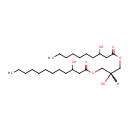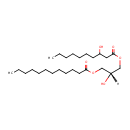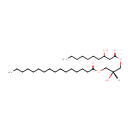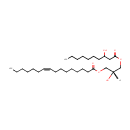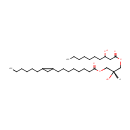
Search Results for compounds
Searching compounds for
returned 4373 results.
Displaying compounds 2821 - 2830 of
4373 in total
CDP-DG(19:iso/17:0cycw7c) (PAMDB006852)
IUPAC:
Not Available
CAS: Not Available
Description: CDP-DG(19:iso/17:0cycw7c) belongs to the family of CDP-diacylglycerols. It is a glycerophospholipid containing a diacylglycerol, with a cytidine diphosphate attached to the oxygen O1 or O2 of the glycerol part. As is the case with diacylglycerols, phosphatidylserines can have many different combinations of fatty acids of varying lengths and saturation attached to the C-1 and C-2 atoms. CDP-DG(19:iso/17:0cycw7c), in particular, consists of one 17-methylocatdecanoyl chain to C-1 atom, and one heptadec-9-10-cyclo-anoyl to the C-2 atom. In Pseudomonas aeruginosa glycerophospholipid metabolism, The biosynthesis of CDP-diacylglycerol (CDP-DG) involves condensation of phosphatidic acid (PA) and cytidine triphosphate, with elimination of pyrophosphate, catalysed by the enzyme CDP-diacylglycerol synthase. The resulting CDP-diacylglycerol can be utilized immediately for the synthesis of phosphatidylglycerol (PG), and thence cardiolipin (CL), and of phosphatidylinositol (PI). CDP-DG(19:iso/17:0cycw7c) is also a substrate of CDP-diacylglycerol pyrophosphatase. It is involved in CDP-diacylglycerol degradation pathway.
CDP-DG(19:iso/19:0cycv8c) (PAMDB006853)
IUPAC:
Not Available
CAS: Not Available
Description: CDP-DG(19:iso/19:0cycv8c) belongs to the family of CDP-diacylglycerols. It is a glycerophospholipid containing a diacylglycerol, with a cytidine diphosphate attached to the oxygen O1 or O2 of the glycerol part. As is the case with diacylglycerols, phosphatidylserines can have many different combinations of fatty acids of varying lengths and saturation attached to the C-1 and C-2 atoms. CDP-DG(19:iso/19:0cycv8c), in particular, consists of one 17-methylocatdecanoyl chain to C-1 atom, and one heptadec-11-12-cyclo-anoyl to the C-2 atom. In Pseudomonas aeruginosa glycerophospholipid metabolism, The biosynthesis of CDP-diacylglycerol (CDP-DG) involves condensation of phosphatidic acid (PA) and cytidine triphosphate, with elimination of pyrophosphate, catalysed by the enzyme CDP-diacylglycerol synthase. The resulting CDP-diacylglycerol can be utilized immediately for the synthesis of phosphatidylglycerol (PG), and thence cardiolipin (CL), and of phosphatidylinositol (PI). CDP-DG(19:iso/19:0cycv8c) is also a substrate of CDP-diacylglycerol pyrophosphatase. It is involved in CDP-diacylglycerol degradation pathway.
CDP-DG(19:iso/19:iso) (PAMDB006854)
IUPAC:
Not Available
CAS: Not Available
Description: CDP-DG(19:iso/19:iso) belongs to the family of CDP-diacylglycerols. It is a glycerophospholipid containing a diacylglycerol, with a cytidine diphosphate attached to the oxygen O1 or O2 of the glycerol part. As is the case with diacylglycerols, phosphatidylserines can have many different combinations of fatty acids of varying lengths and saturation attached to the C-1 and C-2 positions. CDP-DG(19:iso/19:iso), in particular, consists of two 17-methylocatdecanoyl chain at positions C-1 and C2. In Pseudomonas aeruginosa glycerophospholipid metabolism, The biosynthesis of CDP-diacylglycerol (CDP-DG) involves condensation of phosphatidic acid (PA) and cytidine triphosphate, with elimination of pyrophosphate, catalysed by the enzyme CDP-diacylglycerol synthase. The resulting CDP-diacylglycerol can be utilized immediately for the synthesis of phosphatidylglycerol (PG), and thence cardiolipin (CL), and of phosphatidylinositol (PI). CDP-DG(19:iso/19:iso) is also a substrate of CDP-diacylglycerol pyrophosphatase. It is involved in CDP-diacylglycerol degradation pathway.
DG(19:0cycv8c/12:0(3-OH)/0:0) (PAMDB006856)
IUPAC:
(2S)-3-{[10-(2-hexylcyclopropyl)decanoyl]oxy}-2-hydroxypropyl 3-hydroxydodecanoate
CAS: Not Available
Description: DG(19:0cycv8c/12:0(3-OH)/0:0) belongs to the family of Diacylglycerols. These are glycerolipids lipids containing a common glycerol backbone to which at least one fatty acyl group is esterified. DG(19:0cycv8c/12:0(3-OH)/0:0) is also a substrate of diacylglycerol kinase. It is involved in the phospholipid metabolic pathway.
DG(10:0(3-OH)/12:0(3-OH)/0:0) (PAMDB006857)
IUPAC:
(2S)-2-hydroxy-3-[(3-hydroxydecanoyl)oxy]propyl 3-hydroxydodecanoate
CAS: Not Available
Description: DG(10:0(3-OH)/12:0(3-OH)/0:0) belongs to the family of Diacylglycerols. These are glycerolipids lipids containing a common glycerol backbone to which at least one fatty acyl group is esterified. DG(10:0(3-OH)/12:0(3-OH)/0:0) is also a substrate of diacylglycerol kinase. It is involved in the phospholipid metabolic pathway.
DG(10:0(3-OH)/12:0/0:0) (PAMDB006858)
IUPAC:
(2R)-2-hydroxy-3-[(3-hydroxydecanoyl)oxy]propyl dodecanoate
CAS: Not Available
Description: DG(10:0(3-OH)/12:0/0:0) belongs to the family of Diacylglycerols. These are glycerolipids lipids containing a common glycerol backbone to which at least one fatty acyl group is esterified. DG(10:0(3-OH)/12:0/0:0) is also a substrate of diacylglycerol kinase. It is involved in the phospholipid metabolic pathway.
DG(10:0(3-OH)/15:0cyclo/0:0) (PAMDB006859)
IUPAC:
(2R)-3-{[8-(2-butylcyclopropyl)octanoyl]oxy}-2-hydroxypropyl 3-hydroxydecanoate
CAS: Not Available
Description: DG(10:0(3-OH)/15:0cyclo/0:0) belongs to the family of Diacylglycerols. These are glycerolipids lipids containing a common glycerol backbone to which at least one fatty acyl group is esterified. DG(10:0(3-OH)/15:0cyclo/0:0) is also a substrate of diacylglycerol kinase. It is involved in the phospholipid metabolic pathway.
DG(10:0(3-OH)/16:0/0:0) (PAMDB006860)
IUPAC:
(2R)-2-hydroxy-3-[(3-hydroxydecanoyl)oxy]propyl hexadecanoate
CAS: Not Available
Description: DG(10:0(3-OH)/16:0/0:0) belongs to the family of Diacylglycerols. These are glycerolipids lipids containing a common glycerol backbone to which at least one fatty acyl group is esterified. DG(10:0(3-OH)/16:0/0:0) is also a substrate of diacylglycerol kinase. It is involved in the phospholipid metabolic pathway.
DG(10:0(3-OH)/16:1(9Z)/0:0) (PAMDB006861)
IUPAC:
(2R)-2-hydroxy-3-[(3-hydroxydecanoyl)oxy]propyl (9Z)-hexadec-9-enoate
CAS: Not Available
Description: DG(10:0(3-OH)/16:1(9Z)/0:0) belongs to the family of Diacylglycerols. These are glycerolipids lipids containing a common glycerol backbone to which at least one fatty acyl group is esterified. DG(10:0(3-OH)/16:1(9Z)/0:0) is also a substrate of diacylglycerol kinase. It is involved in the phospholipid metabolic pathway.
DG(10:0(3-OH)/17:0cycw7c/0:0) (PAMDB006862)
IUPAC:
(2R)-3-{[8-(2-hexylcyclopropyl)octanoyl]oxy}-2-hydroxypropyl 3-hydroxydecanoate
CAS: Not Available
Description: DG(10:0(3-OH)/17:0cycw7c/0:0) belongs to the family of Diacylglycerols. These are glycerolipids lipids containing a common glycerol backbone to which at least one fatty acyl group is esterified. DG(10:0(3-OH)/17:0cycw7c/0:0) is also a substrate of diacylglycerol kinase. It is involved in the phospholipid metabolic pathway.




